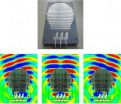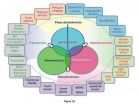(Press-News.org) In a UT Dallas study involving serious youth offenders, the answer to one open-ended question predicted the teenagers' offending patterns for the next seven years: "How long do you think you'll live?"
According to the study, having little hope for the future encourages offending over time.
Author Dr. Alex Piquero said the study found those who don't view a very long life ahead of them offend at very high rates and commit more serious offenses, while those who believe they're going to die much later in life offend much less.
"In a lot of distressed communities and for a lot of offenders, they don't see a future," said Piquero, Ashbel Smith Professor of criminology at UT Dallas. "They think, 'Why do I have to go to school? I'm not going to make it past 21.' And in many of our interviews with these kids, they basically said, 'I'm not going to make it until next week, so why would I even care?'"
The youths' perceptions about how long they would live also impacted how they interpreted the consequences of offending, according to the study.
Teens who anticipated early death were more likely to focus on "the here and the now," Piquero said. They're impulsive; they don't think about the risks of their behavior.
The paper, published online in Justice Quarterly on March 27, used data from a seven-year study of serious youth offenders to examine what has been a relatively uncharted area of empirical research.
Piquero's research began by asking the offenders — approximately 16 years old — their thoughts on when they would die. Their answers ranged from late teens to more than 100 years old, Piquero said.
Researchers followed up with the sample of serious adolescent offenders seven years later, and they self-reported their offending. Those who said they would live longer were more likely to have controlled their impulses.
Piquero said when people in the overall population envision themselves living long lives, they do things that will help them get to that point: they diet, work out, avoid drugs.
"You understand those long-term consequences," Piquero said. "Some kids get that. Other kids have yet to do so."
If youths can envision a longer-term future, they can make better decisions and crime can be reduced, Piquero said. The key is figuring out why some kids have fatalistic views of the future and what it will take to get them to understand long-term consequences. It's important to not "lump together" all youth offenders, Piquero added, because their views of the world vary.
The researcher said the study goes hand-in-hand with President Barack Obama's My Brother's Keeper initiative, a new effort to bolster the lives of young men. The initiative calls for foundations and companies to collaborate to keep young men in school and out of the criminal justice system.
Piquero said the findings can be used to determine how to get these youths to see a life ahead of them and think about what they should do to prepare for that life. If you get them to see a future, it affects how they act now and how they view the world around them now, Piquero said.
"How do we get them to think about a long future?" Piquero asked. "We have to tell them there are rewards for educational and employment investments down the road. The rewards will be fruitful. They'll take some hard work, and they'll take some time, but you can attain those kinds of things."
INFORMATION: END
UT Dallas study: Youth who fail to envision future commit more crimes
2014-04-14
ELSE PRESS RELEASES FROM THIS DATE:
Device turns flat surface into spherical antenna
2014-04-14
WASHINGTON D.C., April 14, 2014 -- By depositing an array of tiny, metallic, U-shaped structures onto a dielectric material, a team of researchers in China has created a new artificial surface that can bend and focus electromagnetic waves the same way an antenna does.
This breakthrough, which the team is calling the first broadband transformation optics metasurface lens, may lead to the creation of new types of antennas that are flat, ultra low-profile or conformal to the shape of curved surfaces.
The new lens, described in AIP Publishing's journal Applied Physics Letters, ...
The science of caffeine, the world's most popular drug (video)
2014-04-14
WASHINGTON, April 14, 2014 — It seems there are new caffeine-infused products hitting the shelves every day. From energy drinks to gum and even jerky, our love affair with that little molecule shows no signs of slowing. In the American Chemical Society's (ACS') latest Reactions video, we look at the science behind the world's most popular drug, including why it keeps you awake and how much caffeine is too much. The video is available at http://youtu.be/YuJOhpNS0IY.
INFORMATION:
Subscribe to the series at Reactions YouTube, and follow us on Twitter @ACSreactions to be ...
Study gives high marks to NC Pre-K program
2014-04-14
Scientists from UNC's Frank Porter Graham Child Development Institute have released their new study of NC Pre-K, the state's program to prepare four-year-olds for success in kindergarten. According to FPG's report, students enrolled in NC Pre-K show significant gains across all areas of learning.
"Children are progressing at an even greater rate during their participation in NC Pre-K than expected for normal developmental growth," said senior scientist Ellen Peisner-Feinberg, who leads the FPG team that has studied the program and provided it with recommendations for ...
Low birth weight, less breastfeeding create later health risks
2014-04-14
Lower weight babies and babies who aren't breastfed or not breastfed for long are at greater risk of developing chronic inflammation and related health problems later in life, according to a new study.
"There were good reasons to hypothesize that breastfeeding was important to influencing levels of inflammation in adulthood," says Thomas McDade (Northwestern University), a CIFAR (Canadian Institute for Advanced Research) Fellow in the Child & Brain Development program. "It changes the microbiome. It promotes development of the immune system. Children who are breastfed ...
Antibiotics alone are a successful treatment for uncomplicated acute appendicitis in kids
2014-04-14
Using antibiotics alone to treat children with uncomplicated acute appendicitis is a reasonable alternative to surgery that leads to less pain and fewer missed school days, according to a pilot study. The research, led by a team at Nationwide Children's Hospital and published online April 12 in the Journal of the American College of Surgeons, is the first prospective study on nonoperative management of acute appendicitis in pediatric patients in the United States.
Researchers enrolled 77 patients age 7 to 17 who were diagnosed with uncomplicated acute appendicitis by ...
Irrational health beliefs linked to skipping cardiac rehab sessions
2014-04-14
COLUMBUS, Ohio – Heart patients with beliefs about health that aren't based on medical evidence are more likely to skip sessions of cardiac rehabilitation, new research suggests.
In the Ohio State University study, a higher number of these beliefs – referred to as "irrational health beliefs" on a standard measure of these thoughts – was associated with lower adherence to a prescribed cardiac rehab program.
Among the irrational beliefs assessed: Doubting the preventive power of the flu vaccine or believing, based on family history alone, that it's safe to smoke cigarettes ...
Three new species of yellow-shouldered bats discovered in museum collections
2014-04-14
Scientists at Chicago's Field Museum and international collaborators have reconstructed the phylogeny and biological history for the Yellow-shouldered bats in the New World tropics, the region of the Earth surrounding the equator. In-depth analysis of mitochondrial and nuclear DNA sequences uncovered three species new to science, each having previously been confused with another species. Since 1960, when modern studies on this group began, Sturnira has grown from eight species to 22. The newest additions were described in a new study, published online in ZooKeys.
The ...
Ex vivo efficacy of C1s antibody as Complement inhibitor in cold agglutinin disease
2014-04-14
SOUTH SAN FRANCISCO, Calif.--True North Therapeutics, Inc., announced today a publication demonstrating that the company's C1s antibody prevents the destruction of human red blood cells exposed to plasma samples of patients with a type of autoimmune hemolytic anemia (AIHA). The article entitled "TNT003, an inhibitor of the serine protease C1s, prevents complement activation induced by cold agglutinin disease patient autoantibodies" was published on-line in the journal Blood earlier this month. TNT003 is the murine analog of True North's lead humanized monoclonal antibody ...
Neuroscientists: Brain activity may mark the beginning of memories
2014-04-14
By tracking brain activity when an animal stops to look around its environment, neuroscientists at the Johns Hopkins University believe they can mark the birth of a memory.
Using lab rats on a circular track, James Knierim, professor of neuroscience in the Zanvyl Krieger Mind/Brain Institute at Johns Hopkins, and a team of brain scientists noticed that the rats frequently paused to inspect their environment with head movements as they ran. The scientists found that this behavior activated a place cell in their brain, which helps
the animal construct a cognitive map, ...
Piezotronics and piezo-phototronics leading to unprecedented active electronics and optoelectronics
2014-04-14
New technologies for developing electronics and optoelectronics with tunable/adaptive functionalities and performance are critical to emerging applications in wearable technology, communication, pervasive computing, human-machine interfacing and biomedical diagnostics, in which the active and adaptive interactions between devices and stimuli from the ambient/host (e. g. human body) are essential. Mechanical stimuli are ubiquitous and abundant in the environment for interacting with or controlling these electronics/optoelectronics. This is, however, not facile to implement ...




